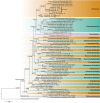Tzeananiaceae, a new pleosporalean family associated with Ophiocordycepsmacroacicularis fruiting bodies in Taiwan
- PMID: 30100794
- PMCID: PMC6072833
- DOI: 10.3897/mycokeys.37.27265
Tzeananiaceae, a new pleosporalean family associated with Ophiocordycepsmacroacicularis fruiting bodies in Taiwan
Abstract
The order Pleosporales comprises a miscellaneous group of fungi and is considered to be the largest order of the class Dothideomycetes. The circumscription of Pleosporales has undergone numerous changes in recent years due to the addition of large numbers of families reported from various habitats and with a large amount of morphological variation. Many asexual genera have been reported in Pleosporales and can be either hyphomycetes or coelomycetes. Phoma-like taxa are common and have been shown to be polyphyletic within the order and allied with several sexual genera. During the exploration of biodiversity of pleosporalean fungi in Taiwan, a fungal strain was isolated from mycelium growing on the fruiting body of an Ophiocordyceps species. Fruiting structures that developed on PDA were morphologically similar to Phoma and its relatives in having pycnidial conidiomata with hyaline conidia. The fungus is characterised by holoblastic, cylindrical, aseptate conidiogenous cells and cylindrical, hyaline, aseptate, guttulated, thin-walled conidia. Phylogenetic analysis based on six genes, ITS, LSU, rpb2, SSU, tef1 and tub2, produced a phylogenetic tree with the newly generated sequences grouping in a distinct clade separate from all of the known families. Therefore, a new pleosporalean family Tzeananiaceae is established to accommodate the monotypic genus Tzeanania and the species T.taiwanensis in Pleosporales, Dothideomycetes. The Ophiocordyceps species was identified as O.macroacicularis and this is a new record in Taiwan.
Keywords: Dothideomycetes; Pleosporineae; Entomopathogenic fungi; Multi-gene analysis; Phoma-like.
Figures




Similar articles
-
Species diversity of Pleosporalean taxa associated with Camellia sinensis (L.) Kuntze in Taiwan.Sci Rep. 2020 Jul 29;10(1):12762. doi: 10.1038/s41598-020-69718-0. Sci Rep. 2020. PMID: 32728102 Free PMC article.
-
Revision of Lophiotremataceae (Pleosporales, Dothideomycetes): Aquasubmersaceae, Cryptocoryneaceae, and Hermatomycetaceae fam. nov.Persoonia. 2017 Dec;39:51-73. doi: 10.3767/persoonia.2017.39.03. Epub 2017 Jun 13. Persoonia. 2017. PMID: 29503470 Free PMC article.
-
Highlights of the Didymellaceae: A polyphasic approach to characterise Phoma and related pleosporalean genera.Stud Mycol. 2010;65:1-60. doi: 10.3114/sim.2010.65.01. Stud Mycol. 2010. PMID: 20502538 Free PMC article.
-
Paramyrothecium eichhorniae sp. nov., Causing Leaf Blight Disease of Water Hyacinth from Thailand.Mycobiology. 2022 Feb 24;50(1):12-19. doi: 10.1080/12298093.2022.2027683. eCollection 2022. Mycobiology. 2022. PMID: 35291591 Free PMC article. Review.
-
DNA sequencing to clarify the taxonomical conundrum of the clinical coelomycetes.Mycoses. 2018 Oct;61(10):708-717. doi: 10.1111/myc.12785. Epub 2018 Jul 17. Mycoses. 2018. PMID: 29693732 Review.
Cited by
-
Species diversity of Pleosporalean taxa associated with Camellia sinensis (L.) Kuntze in Taiwan.Sci Rep. 2020 Jul 29;10(1):12762. doi: 10.1038/s41598-020-69718-0. Sci Rep. 2020. PMID: 32728102 Free PMC article.
-
Neostagonosporellasichuanensis gen. et sp. nov. (Phaeosphaeriaceae, Pleosporales) on Phyllostachysheteroclada (Poaceae) from Sichuan Province, China.MycoKeys. 2019 Feb 18;(46):119-150. doi: 10.3897/mycokeys.46.32458. eCollection 2019. MycoKeys. 2019. PMID: 30814907 Free PMC article.
-
Hidden diversity of Pestalotiopsis and Neopestalotiopsis (Amphisphaeriales, Sporocadaceae) species allied with the stromata of entomopathogenic fungi in Taiwan.MycoKeys. 2024 Jan 31;101:275-312. doi: 10.3897/mycokeys.101.113090. eCollection 2024. MycoKeys. 2024. PMID: 38333551 Free PMC article.
-
Fungal frontiers in toxic terrain: Revealing culturable fungal communities in Serpentine paddy fields of Taiwan.IMA Fungus. 2025 Jun 27;16:e155308. doi: 10.3897/imafungus.16.155308. eCollection 2025. IMA Fungus. 2025. PMID: 40822984 Free PMC article.
-
Phylogenetic diversity and morphological characterization of cordycipitaceous species in Taiwan.Stud Mycol. 2024 Dec;109:1-56. doi: 10.3114/sim.2024.109.01. Epub 2024 Jun 19. Stud Mycol. 2024. PMID: 39717658 Free PMC article.
References
-
- Ariyawansa HA, Jones EBG, Suetrong S, Alias SA, Kang JC, Hyde KD. (2013) Halojulellaceae a new family of the order Pleosporales. Phytotaxa 130: 14–24. 10.11646/phytotaxa.130.1.2 - DOI
-
- Ariyawansa HA, Tanaka K, Thambugala KM, Phookamsak R, Tian Q, Camporesi E, Hongsanan S, Monkai J, Wanasinghe DN, Chukeatirote E, Kang JC, Xu JC, McKenzie EHC, Jones EBG, Hyde KD. (2014) A molecular phylogenetic reappraisal of the Didymosphaeriaceae (= Montagnulaceae). Fungal Diversity 68: 69–104. 10.1007/s13225-014-0305-6 - DOI
-
- Ariyawansa HA, Phukhamsakda C, Thambugala KM, Bulgakov TS, Wanasinghe DN, Perera RH, Mapook A, Camporesi E, Kang JC, Jones EBG, Bahkali AH, Jayasiri SC, Hyde KD, Liu ZY. (2015) Revision and phylogeny of Leptosphaeriaceae. Fungal Diversity 74: 19–51. 10.1007/s13225-015-0349-2 - DOI
-
- Ariyawansa HA, Hyde KD, Liu JK, Wu SP, Liu ZY. (2016a) Additions to Karst Fungi 1: Botryosphaeriaminutispermatia sp. nov., from Guizhou Province, China. Phytotaxa 275: 35–44. 10.11646/phytotaxa.275.1.4 - DOI
-
- Ariyawansa HA, Hyde KD, Thambugala KM, Maharachchikumbura SSN, Al-Sadi AM, Liu ZY. (2016b) Additions to Karst Fungi 2: Alpestrisphaeriajonesii from Guizhou Province, China. Phytotaxa 277: 255–265. 10.11646/phytotaxa.277.3.3 - DOI
LinkOut - more resources
Full Text Sources
Other Literature Sources
Molecular Biology Databases
